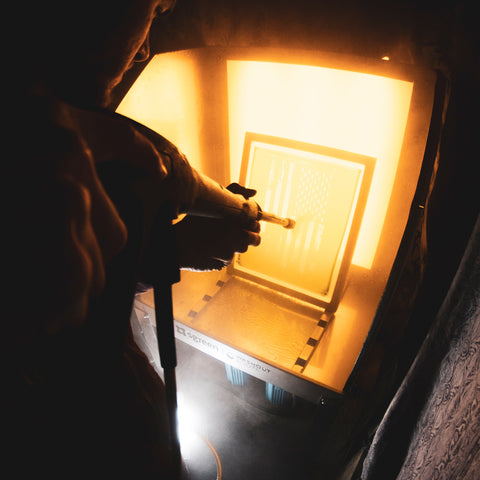Cultivating great screens takes time, practice, and the proper equipment. A washout booth is a great tool to use for rinsing and reclaiming screens. All that water used during these processes needs to go somewhere, though. That’s where a filtration system comes in.

WHAT IS A FILTRATION SYSTEM?
A filtration system filters solids out of the water, keeping your pipes in good condition. It is a series of filters that capture solids and stop them from entering pipes. The main goal is to catch the solids. These are emulsions, inks, and pigments. Every time a screen is rinsed out or reclaimed, the emulsion is going down the drain. Inks often remain congealed as a glob and sometimes even pieces of tape can get washed off and go down the drain. Without a filtration system, all of these go through the pipes.
So how does it work? Filtration starts with a PVC pipe, which attaches underneath the washout booth, that funnels the water to a tank with filters designed to catch different sizes of particulate. The first filter catches all the big particles. Then the water goes through three reusable screens: 110, 156, and 200 meshes. Next, the filtered water flows into a holding tank where a high-powered industrial sump pump is triggered, pushing the water through the final two stages: a 70- and 20-micron disposable filter.
Once the refuse has gone through this six-stage filtering process, the water has been strained multiple times and most solids have been removed. Any remaining particulate has been reduced to 20 microns (0.000787402 inches), making it small enough to go down the drain without constantly worrying about clogging your drain.

WHO NEEDS A FILTRATION SYSTEM
In short, every screen print shop should be using a filtration system. The worst-case scenario of having to replace plumbing can be easily avoided by using some form of filtration during rinse-out and reclaim.
Small shops — reclaiming less than five screens per day — may not need a filtration system immediately. However, any shop doing consistent screen reclaim will benefit from filtering solids out of the plumbing system.
Don’t have the budget to invest in a filtration system? Creating a DIY system works as well. This can be done using buckets or barrels with screens of different mesh sizes placed on top, so the water filters through the screen and solids are stopped.
RELATED: A STEP-BY-STEP GUIDE TO RECLAIMING SCREENS WITH SGREEN SCREEN PRINTING CHEMISTRY
CITY REGULATIONS
Many cities have clean water standards. When starting a screen print shop, it’s essential to check those standards across the board. Make sure the filtered water meets the city’s clean water standards.
This is true of many aspects of screen printing, including waste disposal.

HOW TO DISPOSE OF SOLIDS
Eventually, the screens in the filtration system will need to be replaced. Disposing of those filters may not be as easy as throwing them in the trash. If the city restricts waste disposal, have a waste removal team come to pick up the used filters.
Replace the filters with 16x20 screens in 110, 156, and 230 mesh counts. Admire your work, then get back to reclaiming screens.
Filtration systems will save your plumbing, which will also save tons of money and stress. No matter the size of the shop you have, investing in a filtration system or making your own is a great idea. Your pipes will thank you.
